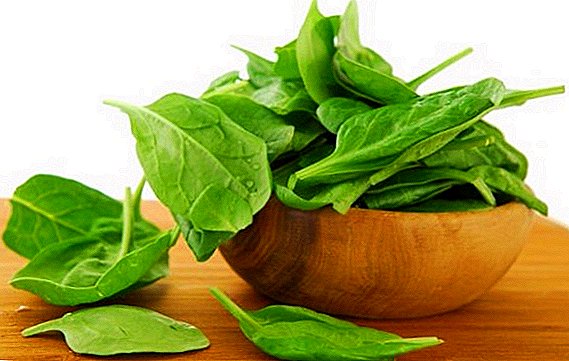 Many housewives prepare sorrel for the winter in their own way, which does not always keep the leaves fresh and tasty. Therefore, we will talk about ways of harvesting sorrel for the winter, which will not require you to spend a lot of time or money.
Many housewives prepare sorrel for the winter in their own way, which does not always keep the leaves fresh and tasty. Therefore, we will talk about ways of harvesting sorrel for the winter, which will not require you to spend a lot of time or money.
Dried sorrel
The easiest and time-tested way to prepare sorrel for the winter is drying. Dry the leaves in two ways: in the air or in an electric dryer.
After collecting, carefully sort the leaves, remove rotted or spoiled. Rinse with water if dust has settled on the sorrel. To dry sorrel in the air, you need to collect greens in small bunches, tie with thick thread and hang in the shade.
Important! Sunlight should not fall on sorrel, otherwise the leaves will discolour and begin to crumble.
When creating beams, remember that the leaves in it should dry the same. If you tie a bundle that is too thick, then the sorrel in the center will not dry, but will scour. Therefore, try to stick to a thickness of no more than 5-7 cm. Also, ensure good air flow if the leaves are to be dried indoors.
 If drying in bundles is inconvenient, then green leaves can be spread out on paper or on a sieve. Remember that the thinner the layer, the faster it will dry out. Even if you have very little space for drying, it is impossible to lay out the sorrel in a layer thicker than 15 cm, as the leaves may rot.
If drying in bundles is inconvenient, then green leaves can be spread out on paper or on a sieve. Remember that the thinner the layer, the faster it will dry out. Even if you have very little space for drying, it is impossible to lay out the sorrel in a layer thicker than 15 cm, as the leaves may rot.
Sorrel can be dried in an electric drier. This method is faster, but not suitable for everyone. Before drying, the sorrel should be finely chopped. First, try drying a small portion to know for sure that you like the quality and taste of the finished product. After several attempts, you will know exactly how long the leaves should be in the dryer.
Ready dry sorrel should be dark green. When pressed, the leaves should fall apart into small pieces. In this case, pay attention to whether the leaves are completely dry or just around the edges. After drying, the store is kept in opaque cans with a twist. Banks should not be placed in a very wet place so that the sorrel will not deteriorate (even the densest lid allows moisture to pass inside the can).
Important! It is worth mentioning oxalic acid, which can exacerbate kidney related diseases. People with high acidity of the stomach should also eat dishes with sorrel in small quantities.
Sorrel freeze
 Many housewives thought about how to keep sorrel in the fridge fresh. Dried sorrel does not have a special freshness or taste, so you can try to freeze the leaves to keep them soft and juicy. Before freezing, sort out the sorrel to get rid of grass or damaged leaves. Next, the sorrel is washed in cold water and dipped for a minute in boiling water. Sorrel will darken a bit, acquiring an olive color.
Many housewives thought about how to keep sorrel in the fridge fresh. Dried sorrel does not have a special freshness or taste, so you can try to freeze the leaves to keep them soft and juicy. Before freezing, sort out the sorrel to get rid of grass or damaged leaves. Next, the sorrel is washed in cold water and dipped for a minute in boiling water. Sorrel will darken a bit, acquiring an olive color.
Important! The color change of sorrel after hot water does not affect the taste and vitamin composition.
After heat treatment, the sorrel is left for a couple of hours to dry and cool. If you put wet sorrel in the freezer, then you end up with just a lump of ice that will take up extra space. After the leaves dry, they need to be expanded in sudochki or plastic bags, which can be easily opened.
When you need sorrel in the winter, you should not defrost it prematurely. In the soup or borsch throw more frozen leaves, which quickly melt and give your dish to the dish.
 There is another freezing method for which a blender is needed. Peeled and washed leaves are crushed in a blender to a state of mashed potatoes, laid out in sudochki and frozen. This method is a little inconvenient, because when you defrost you have to use the whole product. Therefore, crushed sorrel can be put in ice molds. So you can use as much frozen sorrel as you need.
There is another freezing method for which a blender is needed. Peeled and washed leaves are crushed in a blender to a state of mashed potatoes, laid out in sudochki and frozen. This method is a little inconvenient, because when you defrost you have to use the whole product. Therefore, crushed sorrel can be put in ice molds. So you can use as much frozen sorrel as you need.
Sorrel for the winter is frozen, not only to preserve the taste or vitamin composition. This is done to ensure that the leaves do not spoil (as when drying) or are not very salty (as when salting). Freezing preserves the primary taste of the product, so you can not be afraid that the preserved product will spoil the dishes.
Did you know? Due to the high content of tannins in the sorrel, the roots of many species - a valuable raw material for tanning leather. They are used as yellow and red dyes.
Salk sorrel
Our great-grandmothers also knew how to store sorrel: for this they salted it for the winter in banks. This method will never outlive itself, since it does not require much effort or some kind of technology.
Before salting, estimate the amount of sorrel and prepare banks. It is best to pickle the product in half-liter or liter jars. Before salting sorrel must be cleaned and washed. If the sheets are large, cut them, but do not shrink. After that, put sorrel in a container and pour salt at the rate of 15 g of salt per 0.5 kg of sorrel. Stir the chopped leaves with salt and let them stand for 2-3 hours.
 After the sorrel has stood and put the juice in, it must be put into sterilized jars. Banks do not need to roll up, just tightly tighten the lid and put in the refrigerator or cellar.
After the sorrel has stood and put the juice in, it must be put into sterilized jars. Banks do not need to roll up, just tightly tighten the lid and put in the refrigerator or cellar.
We answered the question of how to pickle sorrel. Now tell a few tricks when using it:
- when adding sorrel to the dish, use 3 times less salt;
- Sprinkle sorrel with dill or spinach in equal proportions to enjoy the "vitamin cocktail" in the cold season;
- for salting, use young sorrel so that the product lasts longer and preserves its taste.
Important! Salted sorrel can be stored for about 7-8 months in a cold place.
Sorrel in its own juice
Another interesting green storage method - in its own juice. The advantage of this method of conservation of sorrel is that you can do without adding salt or sugar. This method is ideal for dishes that are prepared strictly according to the recipe, and excess salt or sugar can spoil the taste. It does not need to roll up the banks or boil for a long time, sorrel due to its acid is beautifully stored without the addition of vinegar.
 First you need to prepare sorrel: remove dry leaves, remove grass and other debris, rinse from dust and dirt. Take the largest pot, fill it with half the water and put on the fire. Prepare half-liter (in extreme cases - liter) jars and fill them with sorrel leaves. You can cut the leaves or put them entirely, it all depends on your preferences and the size of the leaves.
First you need to prepare sorrel: remove dry leaves, remove grass and other debris, rinse from dust and dirt. Take the largest pot, fill it with half the water and put on the fire. Prepare half-liter (in extreme cases - liter) jars and fill them with sorrel leaves. You can cut the leaves or put them entirely, it all depends on your preferences and the size of the leaves.
Important! It is strongly recommended to use cans of 0.5 liters or 250 ml, since it is best to keep the sorrel in them.
After you have filled the jars, you need to put them in a pot of water. As soon as the sorrel under the action of temperature will begin to "sit down" -sleep more. When you notice that the sorrel juice has risen to the neck of the jar, the process is complete. Sorrel cans should be slightly cooled and covered with silicone caps. Then you can put the banks either in the refrigerator or in the cellar.
This method does not take as much time as conventional conservation. You can not be afraid that the banks "shoot" or sorrel sour.
Sorrel canning for the winter
 "If the product can be canned, then it must be canned," - so many hostesses will say and they will be right. The process of preserving sorrel for the winter is not very different from seaming vegetables or fruits, but you need to take into account its own characteristics in order to get tasty and juicy greens for borscht.
"If the product can be canned, then it must be canned," - so many hostesses will say and they will be right. The process of preserving sorrel for the winter is not very different from seaming vegetables or fruits, but you need to take into account its own characteristics in order to get tasty and juicy greens for borscht.
To start, prepare our greens for conservation. To do this, clear the sorrel from debris and pour cold water for 20 minutes. This is done in order to completely get rid of dirt. Sterilize the jars and put them on the towel, neck down. Also, do not forget about the sterilization of the lids (for 5 minutes you need to fill only boiling water). After washing the sorrel is cut and put in jars. You do not need to completely discard the stems - they contain a little more acid than the leaves, and it only helps with conservation.
After you have filled the jars, you need to pour boiling water to the top and release the bubbles (for this you can simply put a spoon on top and wait a bit). As soon as all the air is out, add water to the neck and roll it up with an iron lid.
Important! You can add about 1 tsp. salt, after which the sorrel will change color. Salt will not affect the quality of the seaming or the shelf life, whether to add or not is your personal preference.
 There is an alternative way to better preserve the vitamin composition. All actions are repeated as described above, but instead of boiling water, a jar of sorrel is filled with boiled cold or warm water. After that, add 1 tbsp. l salt and 100 g of vinegar (the calculation is carried out on a liter jar). It is worth noting that this method is not suitable for people who do not tolerate very acidic foods.
There is an alternative way to better preserve the vitamin composition. All actions are repeated as described above, but instead of boiling water, a jar of sorrel is filled with boiled cold or warm water. After that, add 1 tbsp. l salt and 100 g of vinegar (the calculation is carried out on a liter jar). It is worth noting that this method is not suitable for people who do not tolerate very acidic foods.
Canned sorrel with greens
You can preserve sorrel with other herbs that grow in your garden. To get a great vitamin roll-in, you can add dill, parsley and green onions.
Did you know? Sorrel is a good blood-purifying, analgesic, hemostatic agent, despite the fact that it is almost never used in scientific medicine.
To start, pick a sufficient amount of sorrel, green onions, dill and parsley in the garden. On one liter jar you will need:
- 750 grams of sorrel;
- 180 grams of green onions;
- 15 g of dill;
- 5g parsley
- 300 ml of water.
Knowing how to prepare sorrel at home, you can at any time of the year please yourself and your relatives with tasty, and most importantly, with healthy borsch.












